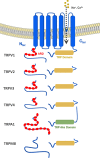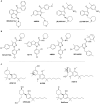Cannabinoid Ligands Targeting TRP Channels
- PMID: 30697147
- PMCID: PMC6340993
- DOI: 10.3389/fnmol.2018.00487
Cannabinoid Ligands Targeting TRP Channels
Abstract
Transient receptor potential (TRP) channels are a group of membrane proteins involved in the transduction of a plethora of chemical and physical stimuli. These channels modulate ion entry, mediating a variety of neural signaling processes implicated in the sensation of temperature, pressure, and pH, as well as smell, taste, vision, and pain perception. Many diseases involve TRP channel dysfunction, including neuropathic pain, inflammation, and respiratory disorders. In the pursuit of new treatments for these disorders, it was discovered that cannabinoids can modulate a certain subset of TRP channels. The TRP vanilloid (TRPV), TRP ankyrin (TRPA), and TRP melastatin (TRPM) subfamilies were all found to contain channels that can be modulated by several endogenous, phytogenic, and synthetic cannabinoids. To date, six TRP channels from the three subfamilies mentioned above have been reported to mediate cannabinoid activity: TRPV1, TRPV2, TRPV3, TRPV4, TRPA1, and TRPM8. The increasing data regarding cannabinoid interactions with these receptors has prompted some researchers to consider these TRP channels to be "ionotropic cannabinoid receptors." Although CB1 and CB2 are considered to be the canonical cannabinoid receptors, there is significant overlap between cannabinoids and ligands of TRP receptors. The first endogenous agonist of TRPV1 to be discovered was the endocannabinoid, anandamide (AEA). Similarly, N-arachidonyl dopamine (NADA) and AEA were the first endogenous TRPM8 antagonists discovered. Additionally, Δ9-tetrahydrocannabinol (Δ9-THC), the most abundant psychotropic compound in cannabis, acts most potently at TRPV2, moderately modulates TRPV3, TRPV4, TRPA1, and TRPM8, though Δ9-THC is not reported to modulate TRPV1. Moreover, TRP receptors may modulate effects of synthetic cannabinoids used in research. One common research tool is WIN55,212-2, a CB1 agonist that also exerts analgesic effects by desensitizing TRPA1 and TRPV1. In this review article, we aim to provide an overview and classification of the cannabinoid ligands that have been reported to modulate TRP channels and their therapeutic potential.
Keywords: TRP channels; TRPA1; TRPM8; TRPV1; cannabidiol; cannabinoids.
Figures






Similar articles
-
Cannabinoids Stimulate the TRP Channel-Dependent Release of Both Serotonin and Dopamine to Modulate Behavior in C. elegans.J Neurosci. 2019 May 22;39(21):4142-4152. doi: 10.1523/JNEUROSCI.2371-18.2019. Epub 2019 Mar 18. J Neurosci. 2019. PMID: 30886012 Free PMC article.
-
Cannabinoid actions at TRPV channels: effects on TRPV3 and TRPV4 and their potential relevance to gastrointestinal inflammation.Acta Physiol (Oxf). 2012 Feb;204(2):255-66. doi: 10.1111/j.1748-1716.2011.02338.x. Epub 2011 Aug 12. Acta Physiol (Oxf). 2012. PMID: 21726418
-
An Analysis of the Putative CBD Binding Site in the Ionotropic Cannabinoid Receptors.Front Cell Neurosci. 2020 Dec 9;14:615811. doi: 10.3389/fncel.2020.615811. eCollection 2020. Front Cell Neurosci. 2020. PMID: 33362478 Free PMC article.
-
Pharmacological actions of cannabinoids.Handb Exp Pharmacol. 2005;(168):1-51. doi: 10.1007/3-540-26573-2_1. Handb Exp Pharmacol. 2005. PMID: 16596770 Review.
-
TRP channels and analgesia.Life Sci. 2013 Mar 19;92(8-9):415-24. doi: 10.1016/j.lfs.2012.08.010. Epub 2012 Aug 14. Life Sci. 2013. PMID: 22910182 Free PMC article. Review.
Cited by
-
Cerebrovascular Effects of Alcohol Combined with Tetrahydrocannabinol.Cannabis Cannabinoid Res. 2024 Feb;9(1):252-266. doi: 10.1089/can.2021.0234. Epub 2022 Sep 15. Cannabis Cannabinoid Res. 2024. PMID: 36108317
-
Cannabinoid combination targets NOTCH1-mutated T-cell acute lymphoblastic leukemia through the integrated stress response pathway.Elife. 2024 Sep 11;12:RP90854. doi: 10.7554/eLife.90854. Elife. 2024. PMID: 39258755 Free PMC article.
-
Impact of Δ9-Tetrahydrocannabinol on Rheumatoid Arthritis Synovial Fibroblasts Alone and in Co-Culture with Peripheral Blood Mononuclear Cells.Biomedicines. 2022 May 11;10(5):1118. doi: 10.3390/biomedicines10051118. Biomedicines. 2022. PMID: 35625855 Free PMC article.
-
Role of Known Transient Receptor Potential Vanilloid Channels in Modulating Cardiac Mechanobiology.Front Physiol. 2021 Oct 15;12:734113. doi: 10.3389/fphys.2021.734113. eCollection 2021. Front Physiol. 2021. PMID: 34867442 Free PMC article. Review.
-
Restorative Effect of Microalgae Nannochloropsis oceanica Lipid Extract on Phospholipid Metabolism in Keratinocytes Exposed to UVB Radiation.Int J Mol Sci. 2023 Sep 20;24(18):14323. doi: 10.3390/ijms241814323. Int J Mol Sci. 2023. PMID: 37762626 Free PMC article.
References
-
- Ahluwalia J., Urban L., Bevan S., Nagy I. (2003). Anandamide regulates neuropeptide release from capsaicin-sensitive primary sensory neurons by activating both the cannabinoid 1 receptor and the vanilloid receptor 1 in vitro. Eur. J. Neurosci. 17, 2611–2618. 10.1046/j.1460-9568.2003.02703.x - DOI - PubMed
Publication types
Grants and funding
LinkOut - more resources
Full Text Sources
Other Literature Sources

